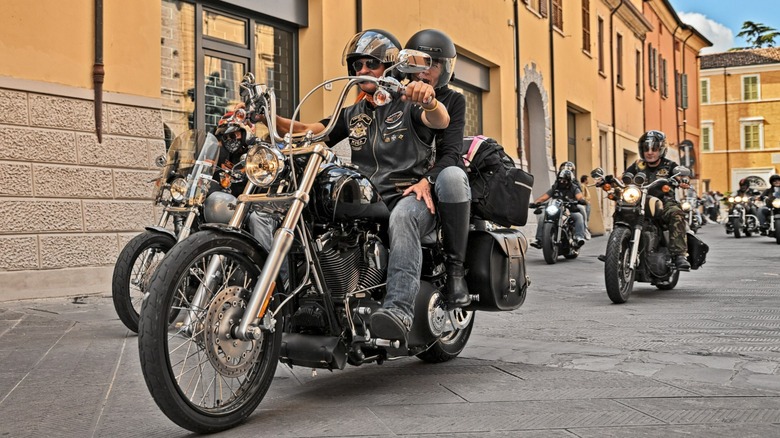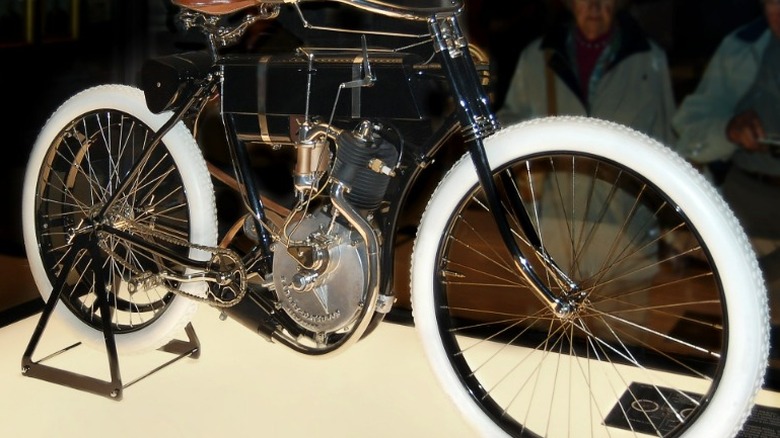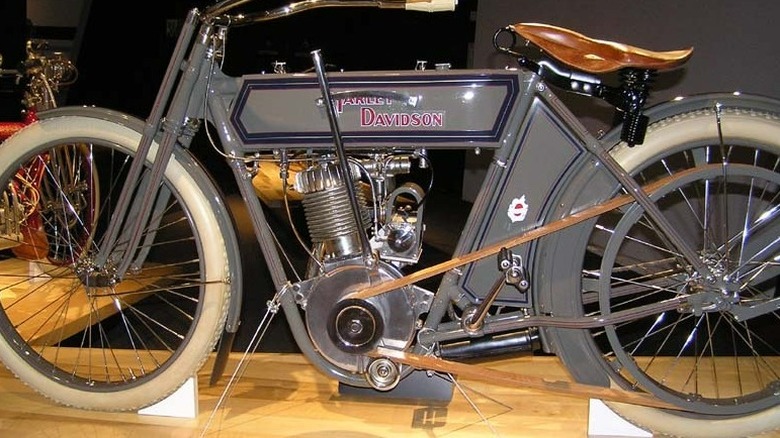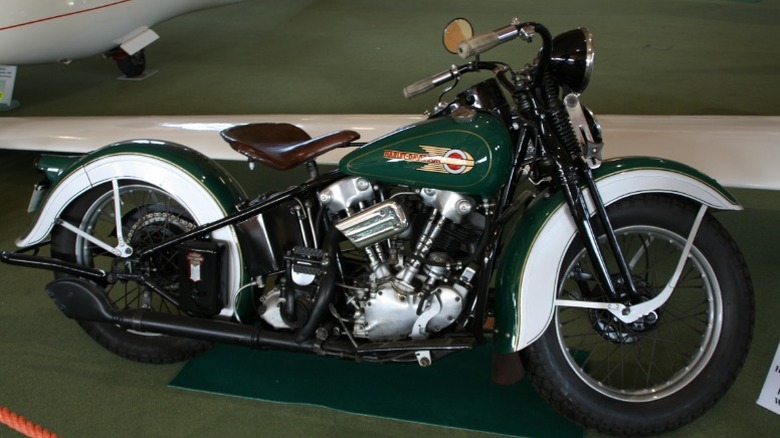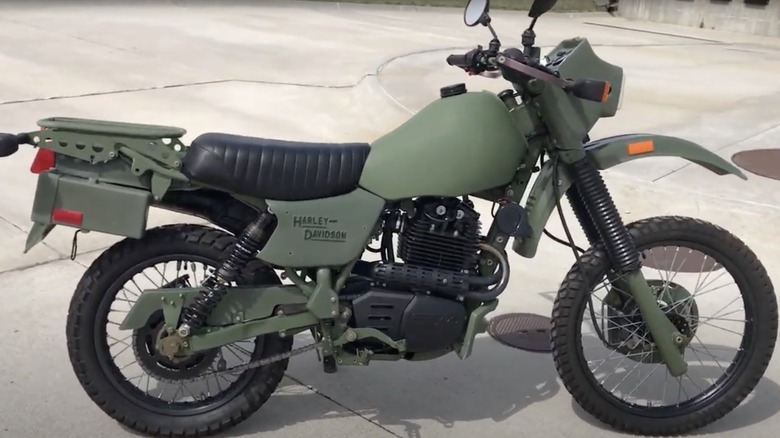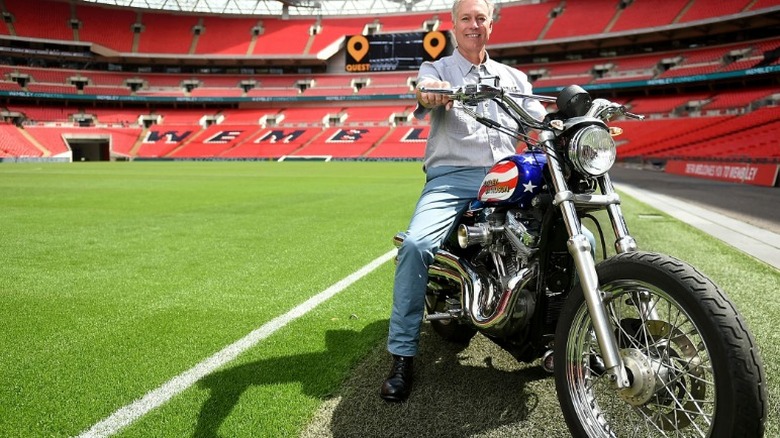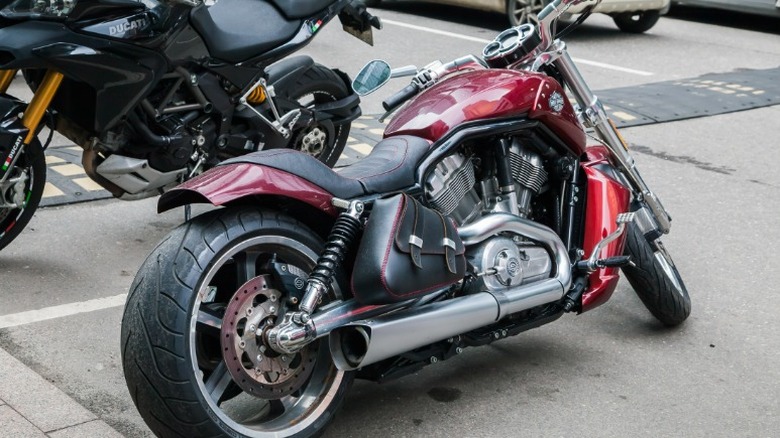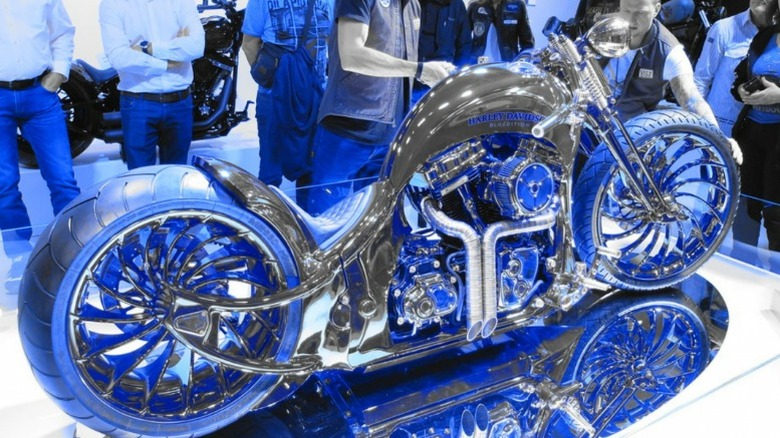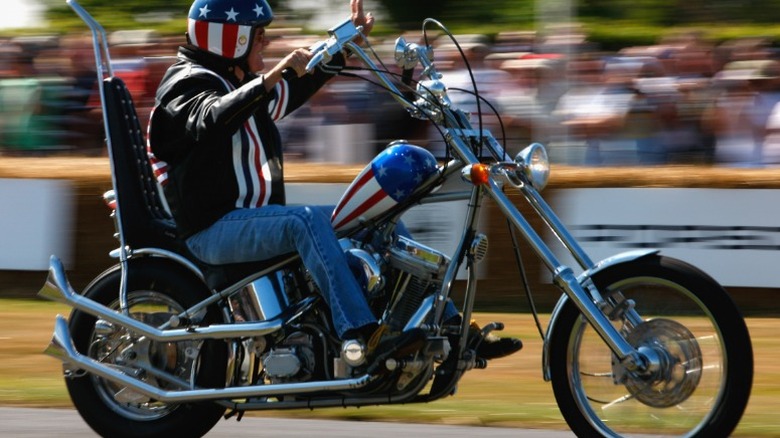The 10 Rarest Harley-Davidson Motorcycles Ever Built
Harley-Davidson has been manufacturing motorcycles for over 100 years. The company employs over 9,000 people worldwide and the company has produced a wide variety of motorcycles during its long history — ranging from small entry-level bikes such as the 1973 Shortster minibike to large V-Twin cruisers such as the CVO models with a Milwaukee-Eight engine generating 126 lb-ft of torque. Some models are standard bikes with equipment typical of competitors in their class while others are unique, and many are rare.
Harley-Davidson is the most popular motorcycle brand in the U.S. According to Dependable, Harley-Davidson retains the top market share in the U.S. and has accounted for about 30% of the country's motorcycle sales. The demand for Harley-Davidson motorcycles has remained strong in recent years even with the COVID pandemic effect, especially in the heavyweight V-Twin cruiser segment. No other motorcycle manufacturer has created a loyal customer base that matches the loyalty of Harley-Davidson customers.
The rare models are mostly vintage bikes with reduced numbers due to wear and tear over the years, models with limited production, and one-off customized special editions. Some of these bikes were so unique, such as the 1925 Scooped-Tank V-Twin which was produced for only one year, that they have become the most sought-after Harley Davidson motorcycles by collectors. Here are 10 of the rarest Harley-Davidson motorcycles ever built.
1903 Harley-Davidson Single
The name of the Harley-Davidson Serial Number One, which currently resides in the lobby at Juneau Avenue, Milwaukee, implies it is the first motorcycle Harley-Davidson ever built. However, that distinction goes to one of the prototypes built before the model displayed at the company's headquarters. The Serial Number One served as a development platform for the production models that followed but is considered one of the rarest Harley-Davidsons ever made.
The first models built from 1903 to 1905 were almost identical. The company fitted the bike with an inlet-over-exhaust single 24.74-cubic-inch (405.41cc) engine with 9-3/4-inch flywheels weighing 28 pounds, an upgrade from prototype models that used a 7.07-cubic-inch (116 cc) engine. The original was designed by William S. Harley and his boyhood friend, Arthur Davidson, for use in a regular pedal bicycle frame. However, the pair soon discovered it lacked hill-climbing power.
The engine was mounted in a tubular loop frame and mated to a single-speed, belt-drive transmission. The bike weighed 185 lb. and reached a top speed of 40mph. Drivers often used the foot pedals to provide additional power. The company assembled the Serial Number One motorcycle without fenders to make the engine visible during competition and to demonstrate its power and reliability. Hagerty estimates the value of a 1903 Harley-Davidson Single to be about $775,000, while Royal Enfield puts the Serial Number One bike at $15 million.
[Featured image by Danemroberts via Wikimedia Commons | Cropped and scaled | CC BY-SA 3.0]
1908 Harley Davidson Strap Tank
The Strap Tank got its nickname from the nickel-plated steel straps that suspended the bike's fuel and oil tank from the frame's crossbar. Harley-Davidson made only subtle changes to the 1908 model. It used a 27-cubic-inch engine fitted with a Schebler carburetor and mated to a belt drive that generated about 4.0 horsepower. The bike employed a rear coaster brake, a Sager-Licensed cushion fork, rode on 2.5-inch x 28-inch tires, and weighed 185 pounds.
During the earliest years, 1904 and 1905, the company produced only eight motorcycles. However, by 1907, manufacturing had increased to about 150 machines. By 1908, the Strap Tank had gained a reputation for toughness and durability, traits that served it well (along with larger tires) on pre-pavement dirt roads. Harley-Davidson won the famous Brass and Horns trophy in 1908 for finishing 50 miles on one quart and one ounce of gasoline. The feat enhanced the company's reputation and boosted sales. Production increased to 450 machines.
The Strap Tank is the oldest Harley-Davidson model still available for purchase by collectors. Earlier models have either been demolished or remain in collections without plans for sale (such as the Harley-Davidson Serial Number One at the company headquarters). However, according to Vintagent, a 1908 Strap Tank sold for $935,000 at a Mecum Auction in Las Vegas on January 28, 2023, becoming the most expensive motorcycle ever sold at any auction.
[Featured image by Digital_Third-Eye via Flickr | Cropped and scaled | CC BY-SA 2.0]
1911 Harley-Davidson 7D
The earliest Harley-Davidson motorcycles were powered by a single-cylinder engine. However, in 1911, the company introduced the 7D, considered to be the first 45-degree twin-cylinder production model with a displacement of 49.5 cubic inches producing 7 horsepower. Only 27 model 7D motorcycles were believed to have been made in 1911 and just four are still known to exist. Harley-Davidson experienced significant growth in 1911, growing from 150 employees in 1910 to 550 by the end of 1911. The factory produced 5,625 units, all model 7s (27 model 7Ds), more than double the previous year's output.
Harley-Davidson made several improvements to model 7, including vertical fins on the head, which provided a larger surface area for heat transfer and promoted better cooling. A belt-drive idler assembly allowed a rider to stop the motorcycle without shutting down the engine. While most of the motorcycles used the older technology with a 30 CID single-cylinder engine, the new V-Twin engine in the 7D became the company's trademark power source in one form or another, giving the Harley-Davidson its identifiable characteristic sound.
According to the Las Vegas Review-Journal, "Some engines hum. Some whine. Others roar. But Harley-Davidson motorcycle engines rumble . . . The sound is so distinctive – and so closely associated with the brand – that Harley-Davidson once sought to have it trademarked (the company ultimately withdrew the application)."
[Featured image by Daniel Hartwig via Wikimedia Commons | Cropped and scaled | CC BY-SA 2.0]
1936 Harley-Davidson El Knucklehead
In 1936, Harley-Davidson surged ahead of its closest competitor, Indian, with the E-series, fitted with a 61-cubic-inch engine. The E, ES, and EL Harley-Davidson models represented a move from the reliable but underpowered flathead V-twin engine to the higher-powered overhead valve pushrod engines. Although Harley-Davidson had built OHV racing engines for more than 20 years, the 1936 E series was its first production overhead valve V-Twin. The Knucklehead moniker came from the bulging polished rocker covers that resembled huge, clenched fists.
The base model E Solo produced 37 horsepower with a compression ratio of 6.5:1; the ES model was built for use in sidecar rigs and produced the same output, while the EL (Special Sport Solo) came with a high compression ratio of 7.0:1 yielding 40 hp. The 61 cubic inch engine was mated to a 4-speed transmission with a hand-shifter and foot clutch. The steel frame featured double-down tubes connected to a Springer fork with oval tubing and a rigid rear with a sprung seat with aront and rear drum brakes. The bike weighs 565 pounds and reached a top speed of 95 mph.
In 1936, Harley-Davidson manufactured 1704 Knuckleheads, comprised of 26 ES versions, 152 E models, and 1,526 El bikes. The 1936 Harley-Davidson El Knucklehead is among the rarest and most desirable American classic motorcycles. According to Hagerty, in 2022, a 1936 Harley-Davidson EL Knucklehead sold at auction for $182,000.
[Featured image by pilot_micha via Flickr | Cropped and scaled | CC BY-SA 2.0]
1999 Harley-Davidson MT500
In 1989, Harley-Davidson bought Armstrong-CCM primarily for the rights to the Rotax engine for use in its dirt-track racing bikes and later to offer a badge-engineered model to the U.S. military. The Harley-Davidson MT500 (Military Transport 500cc) is a remake of the original Armstrong MT500, equipped with a unit construction-designed Rotax air-cooled, single-cylinder engine. A chain-driven single overhead cam (SOHC) drives two intake valves and two exhaust valves per cylinder and uses a 5-speed gearbox shifted with the left foot. Most were fitted with kick starters. Designed specifically for military use, the MT500 met street legal requirements with a single rectangular headlight, turn signals, and a taillight. However, all could be disconnected for stealth missions. The single-rider bike lacked a pillion for a second passenger but was fitted with a rack for gear bags or supplies. All MT500s included a waterproof ABS rifle case mounted on the right rear and two 5-gallon Jerry cans in front for gas or water.
Estimates suggest that Harley-Davidson built only 500 gasoline-powered MT500s for the U.S. military, making it one of the lowest-production motorcycles ever made. The anticipated lucrative contract failed to materialize when all the military branches (as well as NATO and many other militaries) decided to switch to diesel-fueled vehicles only. The number of MT500s that survived is unknown, but resale prices average $8,000.
Evel Knievel's Harley-Davidson XR-750
Harley-Davidson claims the XR-750 dirt track motorbike is the "most successful race bike of all time," and the company's assertion is not without merit. According to Cycle World, the legacy of the XR750 over 50 years includes thirty-seven Grand National Championships and 502 premier class wins. Professional racers Chris Carr, Scott Parker, and Jay Springsteen (three consecutive year AMA GNC victories) jointly have 183 GNC main event victories, and 19 GNC wins on the XR-750.
Harley-Davidson manufactured the XR-750, often referred to as The Beast, 750 Sporster, and Iron 750, from 1972 to 2008 (the replacement XG750R was introduced in 2016). The bike is equipped with an air-cooled, 45-degree inclined V-twin 4-stroke OHV engine with the signature iron cylinder-and-head package. Initially, the cast-iron cylinder heads made the engine susceptible to overheating. Often referred to as "waffle irons," the alloy heads degraded the XR-750's performance in long-distance events. However, Harley-Davidson later changed the cylinder head material to aluminum and paired them with larger cylinder valves for better heat diffusion and more effective cooling.
The rarest XR-750 is the custom 1972 model, made of steel, aluminum, and fiberglass, used by the famed stuntman Evel Knievel. In 1975, he rode the bike while jumping 120 feet over 13 Greyhound buses and later in the same year he cleared 133 feet over 14 buses, setting a world record that remained for 25 years. Knievel's Harley-Davidson XR-750 is currently on display at the Smithsonian's National Museum of American History.
1994 Harley-Davidson VR1000
The VR1000 produced in the 1990s is considered by many cycle enthusiasts to be the rarest Harley-Davidson motorcycle. The company developed the race bike intending to compete in the Superbike World Championship equipping it with an enormous 996cc 60º, liquid-cooled V-twin engine designed and built in-house. It featured double overhead cams, four valves per cylinder, and a Weber fuel injection that helped the engine produce over 135 bhp at 10,000 rpm. The motorcycle easily achieved speeds over 200mph.
The VR1000 used Öhlins adjustable racing forks up front and a Penske monoshock in the rear, mounted to an alloy perimeter frame. Carbon fiber bodywork helped keep the weight to a minimum. The road versions (homologation-production bikes) used 6-pot Wilwood brakes and rode on lightweight Marchesini wheels. The racing models employed 6 pot AP Racing calipers with AP master cylinders. Only 51 VR1000s were made in 1994.
Although on paper, the VR1000 should have dominated in the Superbike World Championship, the motorcycle failed to win a race and in several events was forced to retire in the final laps while in the lead. Despite the massive VR1000 engine, its power lagged behind the competition. However, handling was exceptional, and racers would often make up time through the turns but lose their advantage in the straightaways. The VR1000 race bike's limited production and rarity make it highly sought after by motorcycle collectors.
2002 Harley-Davidson VRSC V-rod
Harley-Davidson manufactured the V-Rod or V-Twin Racing Street Custom (VRSC) motorcycle from 2001 through 2017. At introduction, the bike offered a more aggressive and sporty appearance with features that distinguished it from other Harley models as well as competitor bikes. The V-Rod styling is modeled after Harley-Davidson's drag-racing machines, with a long, wheelbase (67.5 inches) and front forks protruding at a 38-degree angle.
The company teamed up with Porsche Engineering to develop the first Harley-Davidson motorcycle with a liquid-cooled DOHC four-valve V-twin engine, dual overhead cams, and fuel injection, in the same bike. Based on the VR 1000 racing engine architecture and nicknamed the Revolution, the new mill featured a 60-degree vee, instead of the usual 45-degree angle found in the air-cooled pushrod-engine line.
The VRSC v-rod's radical new design represented a rare departure from Harley-Davidson's tradition of making minor improvements when introducing new models. It had a bigger engine, displacing 1130cc (68.95 cubic inches) producing 115.0 hp @ 8250 rpm and 64.9 lb-ft of torque at 6300 rpm. Although the engine still fired in an uneven order, characteristic of a V-twin, the exhaust note differed from the more traditional models. Another V-rod anomaly was the fuel tank. The bike featured a dummy fuel tank without a fuel-filler cap in the normal motorcycle position, and stored fuel in a tank beneath the seat. Filling up the tank required flipping up the seat to access the fuel-filler cap.
Harley Davidson Bucherer Blue Edition
Perhaps the rarest of Harley-Davidson's one-off custom models is the Bucherer Blue Edition. At CHF 1.89 million (just over $2 million), Bucherer claims the Blue Edition is the most expensive motorcycle ever built. A collaboration by Bucherer with the Swiss custom Harley-Davidson workshop Bündnerbike, a team of eight craftspersons dedicated over 2,500 hours to designing and building the motorcycle based on the Softail Slim S. Every metal element of the bike was meticulously crafted by hand from welding to polishing, and many are gold-plated to add extra sparkle.
The bike features diamonds and a safe integrated into the right-hand side of the tank that houses a unique Carl F. Bucherer watch featuring a dial decorated with elements of a motorcycle engine. Bucherer claims it is the only motorcycle in existence with a built-in watch. Samir Merdanovic, Carl F. Bucherer Head of Manufacture Movements explains, "To ensure that the vibrations of the engine do not damage the mechanical movement, we have housed the watch in a kind of cage with an elaborate holder made from silicone rings."
The Bucherer BLUE boasts another unique feature: It is the world's first motorcycle built with heat-proof LED lamps to illuminate the inside of the engine, making the rotating camshaft, valve control, and gold-plated throttle valves visible through a window.
[Featured image by Desio "desmodex" via Flickr | Cropped and scaled | CC BY-SA 2.0]
The Captain America Harley-Davidson Panhead from Easy Rider
"Easy Rider" is considered by many to be the quintessential motorcycle movie, showcasing a lifestyle most Americans were unaware of in the 1960s. The Easy Rider Captain America chopper was controversial and became one of the world's most expensive motorcycles. World War II servicemen returning from their tour of duty started the craze, stripping motorcycles down by cutting fenders and removing parts to simplify the appearance. However, the trend gained significant momentum in the early 1970s with the release of "Easy Rider."
Many custom choppers are well-known to enthusiasts, including the Legends Motorcycle Collection 1960 HD Sportster Chopper and the 2019 Custom Long Fork Harley-Davidson Chopper (based on a 1981 Shovelhead) made by Hawke Lawshe of Vintage Technologies. Choppers are typically built for their appealing extreme proportions but are awkward to ride, sacrificing comfort for art. The extended raked forks make maneuvering the bike difficult at low speeds and a challenge to control through any curves. The steamroller-wide rear tire lacking a suspension offers a harsh ride, while the stretched handlebars tire the rider's shoulders and limit the cruising time.
The Captain America bike has a confusing history including the uncertainty of which bike was the original used in the movie. In 2014, it sold $1.35 million, making it the most expensive motorcycle in the world.
